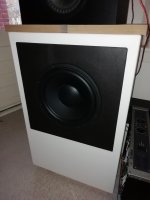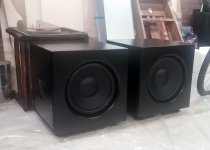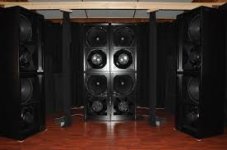The cancellation happens with all dipole speakers, and below the dipole peak, which is determined by the distance between the sources, it falls away at ~6dB/oct, and is EQ-able if necessary (ie, there is still boundary reinforcement and room gain)
Don't forget that part of their (Paradigm) success probably comes from it's specific processing. At least that's how I interpret the results in that review. The advantage of using that many cones is that it will be harder to "overplay" them as a result. They can do what you ask of them, but might need a bit of help to do so.
Don't be afraid to pick drivers with generous x-max and low mass cones that might not keep everything you look for. You can process them, much like a Linkwitz transform to play lower than they would, given the volume etc. as long as that volume is sealed. Processing bass inside the room based on averages to circumvent room anomalies can be done. That gives you the bass that does what that review states. Well defined and with detail. As soon as you find something that works inside the room you loose any boomy bass factor.
I'd look at the Scan Speak 26W for this job. If it is good enough for a monster project like the Beolab 90, an insane speaker project, and you use 6 of them with processing you should get plenty! Even better if you use 2 of those subs in total 😀.
I was re-assured by their use of the 26W in such a high prestige speaker. I've looked at pictures until I found one that confirmed it was indeed the 26W that was used.
I wasn't able to tell (for sure) from this picture:

But when I found some evidence they used a Discovery 26W for that top dollar product, I figured the 30W was going to be good enough for me.

Source is this video at 1:08 on timeline: YouTube
That closed magnet back can only mean it is indeed the 26W.
Even though I now had evidence I still compared all reviews and measurements I could find on both the 30W and 32W. But in the end I am convinced its going to be the added volume displacement together with the room placement and processing that will lead to success. That's why I want the array and sub to "play well together", instead of just handing over that job. Multi-sub works for a reason, figure out why and you're well on your way.
(Sure I still lust for that 32W 😀. I even sized the cabinets for a possible fit down the road. 😱)
Thanks a lot for your valuable input, I appreciate it a lot 😛
Somehow the image attachments does not work for me...
I found a link here where they point to which drivers are in Beolab 90, somehow I tend to think it's quite close to off-the-shelf drivers
Bang & Olufsen BeoLab 90 listening impressions | Part-Time Audiophile
Drivers: Tweeter: 7 x Scan-Speak Illuminator 30 mm. Midrange: 7 x Scan-Speak Illuminator 86 mm. Woofer: 3 x Scan-Speak Discovery 212 mm. Front Woofer: 1 x Scan-Speak Revelator 260 mm.
When there are so many woofers, I don't think there is so much reason to worry about x-max, even with quite significant equalization. Although high x-max is of course an important consideration....
Basically what I am looking for is to make a setup where total q is very low, because in my simple mind I believe that will be one of the required parameters that I need to get really tight bass with no overhead and no ringing, and well, that means expensive Scanspeak or Morel drivers, Scanspeak revelator subwoofers or Morel Titanium former line of subs....
There's also this one....
https://www.scan-speak.dk/datasheet/pdf/22w-4851t00.pdf
6 of these can do a lot 😀
I don't want to derail your thread, so I am probably starting separate thread lining up the concepts that I am thinking about 😛
Last edited:
If you consider the wavelengths involved, you would think so, and not just a short delay. It isn't that straight forward in practice though, consider also that at low frequencies the wave will have reflected around the room a few times before your brain even recognises any particular frequency.But won't a short delay reflection f the signal from the back of an OB off the front wall cancel the direct wave down low? It will be almost 180 degrees out of phase.
Thanks a lot for your valuable input, I appreciate it a lot 😛
Somehow the image attachments does not work for me...
I found a link here where they point to which drivers are in Beolab 90, somehow I tend to think it's quite close to off-the-shelf drivers
Bang & Olufsen BeoLab 90 listening impressions | Part-Time Audiophile
Drivers: Tweeter: 7 x Scan-Speak Illuminator 30 mm. Midrange: 7 x Scan-Speak Illuminator 86 mm. Woofer: 3 x Scan-Speak Discovery 212 mm. Front Woofer: 1 x Scan-Speak Revelator 260 mm.
When there are so many woofers, I don't think there is so much reason to worry about x-max, even with quite significant equalization. Although high x-max is of course an important consideration....
Basically what I am looking for is to make a setup where total q is very low, because in my simple mind I believe that will be one of the required parameters that I need to get really tight bass with no overhead and no ringing, and well, that means expensive Scanspeak or Morel drivers, Scanspeak revelator subwoofers or Morel Titanium former line of subs....
There's also this one....
https://www.scan-speak.dk/datasheet/pdf/22w-4851t00.pdf
6 of these can do a lot 😀
I don't want to derail your thread, so I am probably starting separate thread lining up the concepts that I am thinking about 😛
Real tight bass is having a real good 100-200 Hz impact, as well as lining it up good enough with even higher frequencies 🙂. Play a sub, the best in the world, only below 80 Hz and tell me what you hear.
Having a great bottom end can act like an atmosphere generator though! Sounds lovely.
Just read the reviews linked in my first post and consider the Q of the line arrays. How is that possible?
Last edited:
Hi Haraldo:
If you want an extremely linear woofer array, look at the THD vs excursion curve on this one:
KA-7NEO - Kravchenko-Audio
I'm not sure how available that driver is but I've never seen a THD curve anything like that one.
If you want an extremely linear woofer array, look at the THD vs excursion curve on this one:
KA-7NEO - Kravchenko-Audio
I'm not sure how available that driver is but I've never seen a THD curve anything like that one.
Having a great bottom end can act like an atmosphere generator though! Sounds lovely.
That what I meant with ....and acoustical information related to low frequency....
Good to see that the subs in Assen are about ready (I brought the amplifiers for these quite some time ago... 😉).
This is my 30W implementation:
80 liter aperiodic; enclosure made of 30 mm beech (not birch) ply.
After numerous OB experiments I now have the bass (impact) I do not want to miss anymore.
Attachments
The impact you speak of is perfectly achievable with OB, if just requires more work from the system
Hi Haraldo:
If you want an extremely linear woofer array, look at the THD vs excursion curve on this one:
KA-7NEO - Kravchenko-Audio
I'm not sure how available that driver is but I've never seen a THD curve anything like that one.
Yah, and there is an 8 inch version too ... 🙄
Could these curves have been made with "pink sunglasses"?
Real tight bass is having a real good 100-200 Hz impact, as well as lining it up good enough with even higher frequencies 🙂. Play a sub, the best in the world, only below 80 Hz and tell me what you hear.
Having a great bottom end can act like an atmosphere generator though! Sounds lovely.
Just read the reviews linked in my first post and consider the Q of the line arrays. How is that possible?
Still, I guess you would need drivers to respond timely under 80 Hz
Yes, one of the great things about good bass is not the bass itself but the added dimension and feeling of space and room 🙄
re pink
I would say not. Mark Kravchenko is a really good engineer that frequents these forums and likes to go to extremes to get extremely good results.
I would say not. Mark Kravchenko is a really good engineer that frequents these forums and likes to go to extremes to get extremely good results.
The impact you speak of is perfectly achievable with OB, if just requires more work from the system
We differ in our perception of "impact" I guess 😉
Depending on the recording, very low bass can almost make you feel the venue breatheYes, one of the great things about good bass is not the bass itself but the added dimension and feeling of space and room 🙄
Depending on the recording, very low bass can almost make you feel the venue breathe
Which you don't get with open baffle bass, unless physics are different where you live...
Sorry to have been away for the rest of these discussions, I wanted to make sure I could see double today.

View the data online, I'm pretty convinced the 26w would do everything you want and more. That is, if you're not shy about using some DSP.
If you're set to get it working using T/S parameters and no processing, it becomes a different kind of challenge. Especially inside the room. Throwing those woofers inside a sealed box should first be tested (simulated) to see the effect that has. I can't see it working well without some DSP.
Paradigm uses ARC processing, I've played with that in the past.
A first reference to the 26W: 26W-4558T00-II
Still, I guess you would need drivers to respond timely under 80 Hz
Yes, one of the great things about good bass is not the bass itself but the added dimension and feeling of space and room 🙄
View the data online, I'm pretty convinced the 26w would do everything you want and more. That is, if you're not shy about using some DSP.
If you're set to get it working using T/S parameters and no processing, it becomes a different kind of challenge. Especially inside the room. Throwing those woofers inside a sealed box should first be tested (simulated) to see the effect that has. I can't see it working well without some DSP.
Paradigm uses ARC processing, I've played with that in the past.
A first reference to the 26W: 26W-4558T00-II
Attachments
Last edited:
Now you are just being silly 🙄Which you don't get with open baffle bass, unless physics are different where you live...
Wouuuu wesayso that stereo set of double fish eyes looks fantastic, hope your big cat was it mainecoon race will play games elsewhere ...😛
Hey, I see your subwoofers turned out great!
Really like the strong look.
I see some people got inspired too, that's awesome.
Hope you will enjoy them, and welcome to the club!
Really like the strong look.
I see some people got inspired too, that's awesome.
Hope you will enjoy them, and welcome to the club!
Which you don't get with open baffle bass, unless physics are different where you live...
Now you are just being silly 🙄
Hey guys, get a room 🙂, I'd suggest the subwoofer forum.
There is a place for all of us, but we should respect our differences.
I have seen one open baffle bass setup that I would have liked to hear:
Sadly the pictures have mostly disappeared, but this was StigErik's setup with 8x 21" Beyma subwoofers. I have been an avid follower of his topic out of pure curiosity.
Attachments
Wouuuu wesayso that stereo set of double fish eyes looks fantastic, hope your big cat was it mainecoon race will play games elsewhere ...😛
I share your worries! 😀
Our cat is a cross between a Norwegian Forest cat and a Maine Coon.
So far she has shown no interest in the TC9's, but all of our furniture, my office chair and everything slightly fuzzy (such as the benches I will replace) has been her target. 😱
Of course, everyone has preferences, but physics is a fact and SPL is SPL, the air molecules don't care, it's not easy to get LF bass from OB but it's not impossible either, which is what seems to be being implied.There is a place for all of us, but we should respect our differences.
- Home
- Loudspeakers
- Full Range
- The making of: The Two Towers (a 25 driver Full Range line array)


